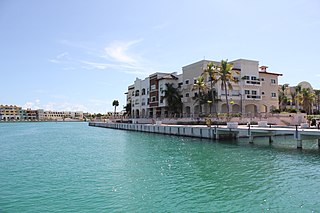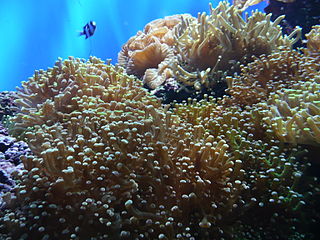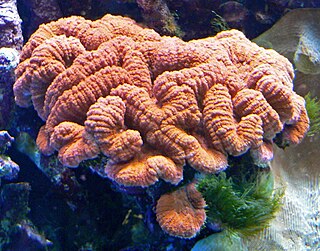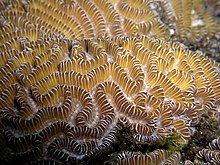
Punta Cana is a resort town in the easternmost region of the Dominican Republic. It is part of the Veron-Punta Cana municipal district, in the Higüey municipality of La Altagracia Province. According to the 2010 census, this district had a population of 43,982 inhabitants.

Acropora is a genus of small polyp stony coral in the phylum Cnidaria. Some of its species are known as table coral, elkhorn coral, and staghorn coral. Over 149 species are described. Acropora species are some of the major reef corals responsible for building the immense calcium carbonate substructure that supports the thin living skin of a reef.

Eupleridae is a family of carnivorans endemic to Madagascar and comprising 10 known living species in seven genera, commonly known as euplerids, Malagasy mongooses or Malagasy carnivorans. The best known species is the fossa, in the subfamily Euplerinae. All species of Euplerinae were formerly classified as viverrids, while all species in the subfamily Galidiinae were classified as herpestids.

The banded linsang is a linsang, a tree-dwelling carnivorous mammal native to the Sundaic region of Southeast Asia.

The purple-crested turaco is a species of bird in the clade Turaco with an unresolved phylogenetic placement. Initial analyses placed the purple-crested turaco in the family Musophagidae, but studies have indicated that these birds do not belong to this family and have been placed in the clade of Turacos with an unresolved phylogeny. It is the National Bird of the Kingdom of Swaziland, and the crimson flight feathers of this and related turaco species are important in the ceremonial regalia of the Swazi royal family.

Goniopora, often called flowerpot coral, is a genus of colonial stony coral found in lagoons and turbid water conditions. Goniopora have numerous daisy-like polyps that extend outward from the base, each tipped with 24 stinging tentacles which surrounds a mouth.

Juan Sebastián Verón is an Argentine former professional footballer and current chairman of Estudiantes de La Plata, where he had served as Director of Sports. A former midfielder, Verón's career started in Estudiantes, continued in Argentina's Boca Juniors, and included stints in several clubs in the Italian Serie A, and England's Manchester United and Chelsea. In 2006, Verón returned to Estudiantes, where he remained until his retirement in 2014, aside from a brief spell with Brandsen. He announced his short return to first team football would occur in the 2017 Copa Libertadores.

Pocillopora is a genus of stony corals in the family Pocilloporidae occurring in the Pacific and Indian Oceans. They are commonly called cauliflower corals and brush corals.

Euphyllia is a genus of large-polyped stony coral. Several species are commonly found in marine aquariums. The genus includes the following species:

Lobophyllia, commonly called lobed brain coral or lobo coral, is a genus of large polyp stony corals. Members of this genus are sometimes found in reef aquariums.

Galaxea is a genus of colonial stony corals in the family Euphylliidae. Common names include crystal, galaxy, starburst and tooth coral. They are abundant on reefs in the Indo-Pacific region and the Red Sea. They are found in water less than 20 metres (66 ft) deep and favour turbid sites. They are sometimes kept in reef aquaria.

María de los Angeles Verón is a 23-year-old woman who was kidnapped on April 3, 2002, from her home town in Tucumán Province in the northwest of Argentina. She has still not been found. Evidence suggests that she was kidnapped by human traffickers in order to force her into prostitution, and may have been forcibly transported to either La Rioja Province, Argentina or Spain.

Acropora aculeus is a species of acroporid corals found throughout the Indian Ocean, the central Indo-Pacific, Australia, southeast Asia, Japan and the East China Sea. It is also present in the western Pacific Ocean. It is an uncommon species and is particularly prone to coral bleaching, disease, and crown-of-thorns starfish predation; it is also harvested for use in aquaria, and the International Union for Conservation of Nature has assessed it as being a "vulnerable species". Habitat loss is a big concern.

Goniastrea is a genus of stony corals in the family Merulinidae. Species belonging to the genus Goniastrea forms massive colonies, usually spherical or elongate, with well developed paliform lobes. Polyps can be seen only at night.

Lobophylliidae is a family of large polyp stony corals. The family was created in 2009 after a revision of the "robust" families of Faviidae, Merulinidae, Mussidae and Pectiniidae, which had been shown to be polyphyletic. The family Lobophylliidae was formed out of the Indo-Pacific species that had traditionally been included in Mussidae, and some of the species which had previously formed Pectiniidae, the remaining species from Pectiniidae having been merged into Merulinidae. The type genus is Lobophyllia.

Merulinidae is a family of reef-building stony corals.
Acropora abrolhosensis is a species of acroporid coral that was first described by John Veron in 1985. Found in sheltered lagoons and shallow reefs, it is listed as a vulnerable species on the IUCN Red List. The population of the species is decreasing, and most specimens are found in Western Australia, but occurs in many other areas. It is also listed under CITES Appendix II.

Platygyra lamellina, the hard brain coral, is a species of colonial stony coral in the family Merulinidae. It occurs on reefs in shallow water in the Indo-Pacific region. The International Union for Conservation of Nature has assessed its conservation status as being "near threatened".

Neogale is a genus of mustelid native to the Americas, ranging from Alaska south to Bolivia. Members of this genus are known as New World weasels.


















